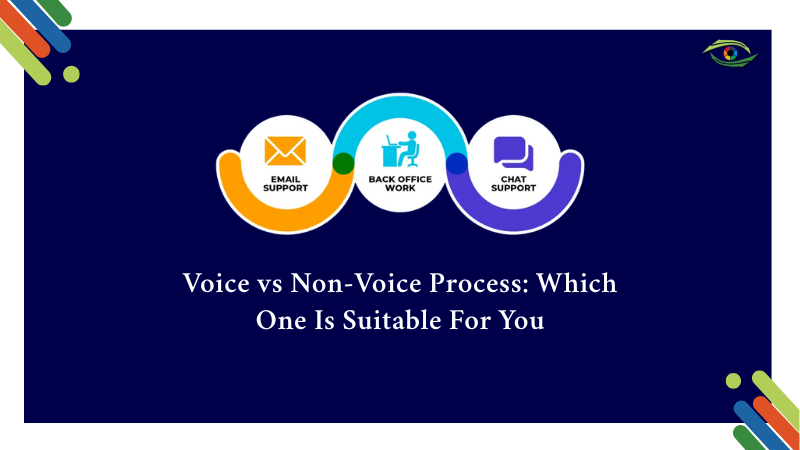
To compete in the fast-evolving business market, it has become prominent to provide satisfactory customer support. The two most dominating service models that brands outsource are voice and non-voice processes. Both of these services help deliver efficient operations to serve various businesses across different industries, goals, and customer expectations.
The question that many businesses ask themselves is which one to choose between voice and non-voice processes. In this blog, let's have a look at what each of these processes are and help you determine which option aligns best with your business needs.
The voice process involves real-time interaction between agents and customers via calls. These inbound and outbound services are about receiving customer calls and calling customers for sales, support, or surveys. The following are the tasks that are commonly done in the voice process:
The key features of this process include real-time communication, personalized interactions, quick issue answers, and the requirement of strong verbal and interpersonal skills.
The non-voice process involves communication via multiple text-based channels like email, live chat, SMS, and social media. This process also includes operations like content moderation service, data entry, and report generation. The list of common tasks under the non-voice process are:
The key features of this process include near-real-time interaction and written communication. It is great for multitasking and handling multiple queries simultaneously.
| Criteria | Voice Process | Non-Voice Process |
|---|---|---|
| Communication Type | Verbal (Via Calls) | Text-Based (Email, Chats, Etc.) |
| Customer Experience | Personalized, High Touch | Documented, Efficient |
| Response Time | Immediater | Real-time or Delayed (Depending on channels) |
| Required Skillset | Strong Verbal and Listening | Typing, Reading Comprehension, Multitasking |
| Cost Efficiency | Generally High | Most Cost-Effective |
| Monitoring | QA Reviews, Call Monitoring | Analytical Tools, Chat/Email Transcripts |
The use of voice processes is best suited where human connection, empathy, and immediacy are required. Following are the scenarios where verbal/voice support works great:
Customers often prefer to connect through call when in anger, confusion, or in distress. In that situation, voice support helps calm the customer explain processes, and offer reassurance.
In the voice process, the calling agents can build connections, address objections in real time and create personalized sales pitches.
With complex issues, the customer and agent are required to communicate back and forth. The voice support reduces the friction of typing explanations to guide customers.
Most of the premium clients/customers often expect dedicated support via call as a part of service-level agreements.
The non-voice process works great in situations that need efficiency, documentation, and scalability. The ideal use of non-voice process services includes:
The non-voice process helps in handling a high volume of FAQs, order tracking, or appointment confirmations with support like chatbots, email templates, or auto-replies.
With non-voice process support, businesses can connect to customers around the clock, in different time zones, and with language barriers.
Through the support of a non-voice process, agents can handle multiple chats or emails and improve cost per resolution as well as team productivity.
This process provides a clear record of communication on chats and emails for audits, compliance, or performance reviews.
If you are still unsure about which process is the right for you, here are the key consideration factors:
The Non-Voice Support often benefits E-commerce, retail, and logistics as it helps in tracking, returns, and refunds.
Healthcare, BFSI, and telecom require voice processes for sensitive conversations and non-voice for billing or records.
For every business, customer preferences are a major aspect. Some businesses require chat or social media, while others still value a phone conversation.
In terms of costing, non-voice processes work under fewer resources per interaction which makes it more budget-friendly in high-volume scenarios.
Types of Support Required
To support your business with its unique needs and goals, choosing between voice and non-voice processes is done by understanding your business goals, customer expectations, and available resources. At Razor Infotech, we cater to our client's needs with both voice and non-voice BPO customer services. With the right outsourcing process, you can unlock optimized customer engagement, reduced costs, and competitiveness to stay in the market.
The non voice process includes analyzing data, compiling reports, and communicating via various channels such as chats, emails, etc.
The voice process simply means real-time communication between agents and customers via phone calls. This includes customer support, sales calls, technical assistance, and telemarketing.
Generally, the non-voice processes are more cost-efficient as they allow agents to take care of multiple inquiries.
At Razor Infotech, we offer both the non-voice processes and voice processes to cater needs of businesses from different industries and of any size.